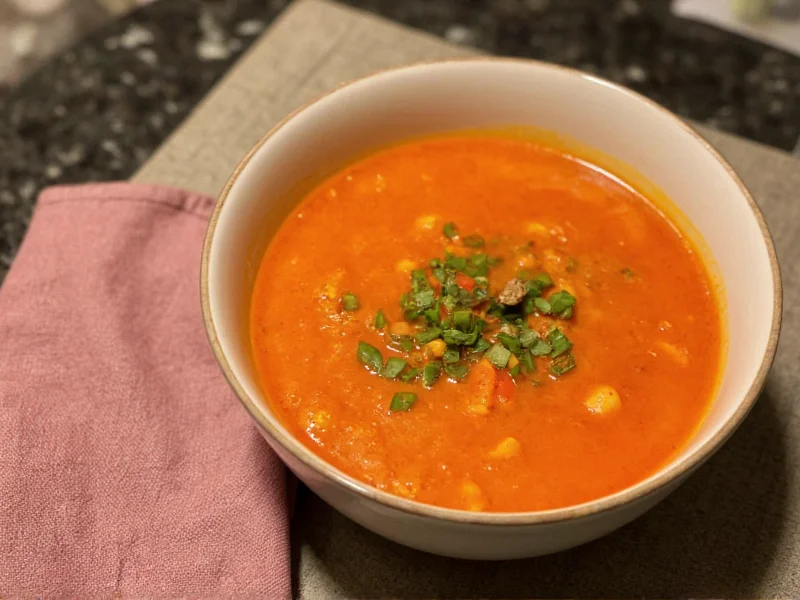If your soup is too spicy, the most effective immediate solutions are to dilute it with additional broth or water, add dairy like yogurt or cream, incorporate starches such as potatoes or rice, or balance the heat with sweeteners like sugar or honey. For best results, start with small additions and taste frequently, as you can always add more but can't remove excess ingredients once incorporated.
Discovering your soup has become unexpectedly spicy can ruin a carefully prepared meal. Whether you accidentally added too much chili, cayenne, or hot sauce, understanding the science behind spice reduction helps you rescue your dish without compromising flavor. This guide provides practical, kitchen-tested methods to reduce spiciness while maintaining your soup's intended taste profile.
Understanding Spice in Soup
Spiciness primarily comes from capsaicin, the compound found in chili peppers that triggers heat receptors in your mouth. Since capsaicin is oil-soluble but not water-soluble, simply adding water won't effectively reduce the heat. Instead, you need ingredients that can bind with or dilute these oil-based compounds.
Most Effective Methods to Reduce Spiciness
Dilution with Liquid Base
Adding more broth, stock, or even water is the simplest approach to make soup less spicy without changing flavor significantly. For every cup of soup that's too spicy, add ¼ to ½ cup of additional liquid. Bring the mixture back to a simmer to allow flavors to reintegrate. This method works best when you haven't yet served the soup and have time to adjust seasoning.
Dairy Products for Heat Neutralization
Dairy contains casein, a protein that binds with capsaicin and helps wash it away. Effective dairy options include:
- Full-fat yogurt (stir in 2-3 tablespoons)
- Cream or half-and-half (¼ cup per serving)
- Sour cream (stir in gradually)
- Cheese like queso fresco or feta (crumbled on top)
For how to tone down spicy soup while adding richness, dairy products offer immediate relief without altering the fundamental character of your dish.
Starches to Absorb Excess Heat
Starchy ingredients can absorb some of the spicy oils. Try these approaches:
- Add diced potatoes and simmer for 10-15 minutes, then remove them
- Stir in cooked rice, beans, or lentils to stretch the soup
- Add a slice of bread and simmer briefly before removing
This method works particularly well for fix soup that's too spicy when you need to maintain the soup's liquid volume while reducing heat.
Sweeteners to Counteract Heat
Sweetness naturally balances spiciness. Add small amounts of:
- Sugar (start with ½ teaspoon)
- Honey (¼ teaspoon at a time)
- Maple syrup
- Tomato paste (adds sweetness while deepening flavor)
When you need to reduce heat in soup naturally, sweeteners provide a chemical counterbalance to the capsaicin without introducing new flavors.
Acidic Components for Balance
Acidity can help cut through spiciness. Consider adding:
- Lime or lemon juice (start with 1 teaspoon)
- Vinegar (a few drops of apple cider or rice vinegar)
- Citrus zest for flavor without additional liquid
This approach works well for how to counteract too much spice in soup in Asian or Latin American dishes where acidity complements existing flavors.
| Method | Effectiveness | Time Required | Flavor Impact |
|---|---|---|---|
| Dilution with broth | ★★★★☆ | 5-10 minutes | Mild |
| Dairy products | ★★★★★ | Immediate | Moderate |
| Starch absorption | ★★★☆☆ | 10-15 minutes | Moderate |
| Sweeteners | ★★★☆☆ | Immediate | Moderate |
| Acid balancing | ★★★☆☆ | Immediate | Mild |
Less Effective Methods Worth Considering
Fats and Oils
Since capsaicin is oil-soluble, adding fats like coconut milk, olive oil, or avocado can help distribute the heat more evenly, making it seem less intense. While this doesn't eliminate spiciness, it can create a more balanced mouthfeel. This approach works best for solutions for overly spicy soup when other ingredients aren't available.
Time-Based Reduction
Simmering your soup longer can sometimes mellow the spiciness as volatile compounds evaporate. However, this method has limited effectiveness with capsaicin, which is quite stable. It works better for fresh chilies than dried spices. For those wondering how to fix chili that's too hot, extended simmering combined with other methods yields better results.
Methods to Avoid: Common Myths
Several popular "solutions" for spicy soup don't work as advertised:
- Adding more salt - Salt enhances flavors but doesn't reduce heat
- Adding alcohol - While alcohol dissolves capsaicin, cooking it off leaves the heat behind
- Adding more spices - This usually compounds the problem rather than solving it
Understanding what not to do is crucial when you need to neutralize spiciness in soup effectively.
Prevention Tips for Future Batches
The best way to handle spicy soup is to prevent it from happening:
- Add spicy ingredients gradually, tasting as you go
- Start with half the recommended amount of chili peppers or hot sauce
- Remove seeds and membranes from fresh chilies (where most capsaicin resides)
- Use mild varieties of peppers when possible
- Keep dairy or starch components ready as backups
These practices ensure you never have to ask how to make soup less spicy in the first place.
Special Considerations for Different Soup Types
The best approach varies by soup base:
- Cream-based soups: Add more dairy rather than liquid to maintain texture
- Tomato-based soups: Balance with a touch of sugar and dairy
- Asian broths: Use coconut milk and lime for authentic flavor preservation
- Bean or legume soups: Add more beans to absorb excess heat
Knowing the best way to reduce spiciness in soup depends on your specific recipe and cultural context.
When All Else Fails: Creative Solutions
If your soup remains too spicy after multiple attempts:
- Repurpose it as a sauce for proteins or vegetables
- Freeze portions for future use in smaller quantities
- Transform it into a different dish (spicy soup can become a great base for braising)











 浙公网安备
33010002000092号
浙公网安备
33010002000092号 浙B2-20120091-4
浙B2-20120091-4